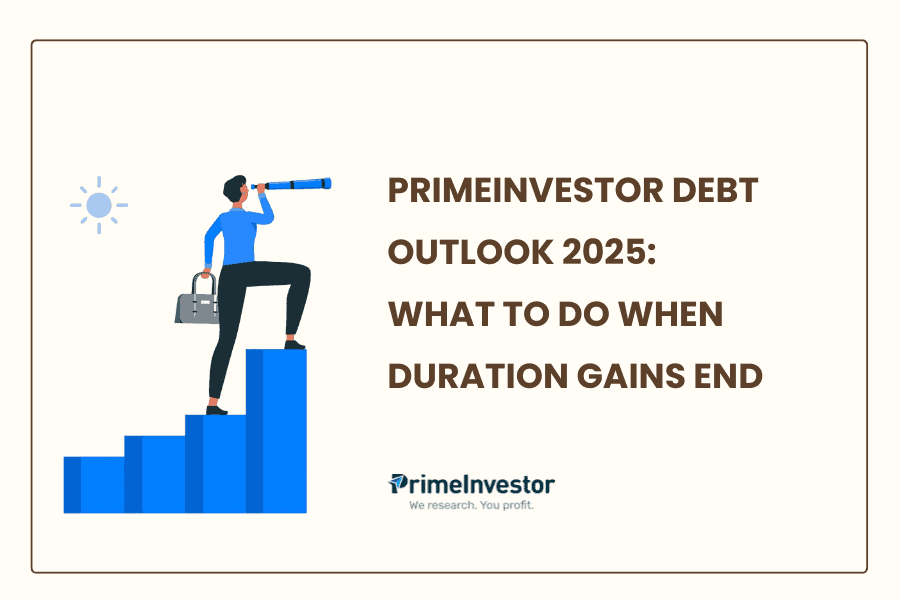If 2024 was a frustrating year for Indian equity investors, it was worse for debt investors. As the Monetary Policy Committee (MPC) was done with its rate hikes way back in February 2023, market participants expected from the beginning of the year that it would begin its easing cycle. Election results signaled continuity on fiscal consolidation by the Centre and the July Budget reiterated this. This primed the markets for rate cuts after the general elections. But the MPC did not oblige. As we write this, the MPC continues to sit on the fence, citing food inflation.

At PrimeInvestor we were not as bullish as market participants at the beginning of the year. We expected rate cuts only in the second half of 2024 or after. We reviewed this stance in August 2024, to predict that markets would run ahead of MPC. This split view prompted us to recommend a barbell strategy to our subscribers, which required debt investments to be split between low/short duration debt and constant maturity or long-duration gilt funds.
Though the MPC is still on hold, this strategy has delivered results. The short duration debt fund category ended 2024 with an 8.2% return. The long duration category has managed 11.3% and constant maturity gilt funds delivered 9.5%.
Here’s what debt investors should expect in the year ahead.
MPC may cut rates
Much like the story of the boy who cried wolf, investors have begun to tire of hearing that repo rate cuts are just around the corner. One can’t blame them really. But three factors suggest that the MPC does have a good case for rate cuts.
# Dwindling growth
Throughout the financial year 2023-24, the MPC took the line that the Indian economy did not really need any help from monetary policy, because it was firing on all cylinders. Until the March quarter of 2024, India’s real GDP growth surprised everyone by racing ahead at 8% plus.
But with elections and a dip in consumption acting as speed-breakers, the economy has swiftly lost speed in the June and September quarters of 2024, with real GDP growth at just 6.7% and 5.4% respectively. Not only were these growth prints lower than market expectations, but they also undershot MPC’s rosy forecasts of 7.3% and 7% by 60 and 160 basis points respectively.
With most forecasters now expecting real GDP growth to come in at 6.5-6.8% for FY25 and remain around 7% next year, MPC can no longer argue that there is no need for monetary stimulus to the economy.
# Change of guard at RBI
External members of the MPC have been consistently pushing for a 25-basis point rate cut in recent meetings, with 2 of the 6 members batting for easing. It was the RBI members of the MPC, including Governor Das, who were the hawkish influence behind holding rates. The Central government has recently appointed the Revenue Secretary Sanjay Malhotra as the new RBI Governor, bidding adieu to Das. Both the Finance Minister and Chief Economic Advisor have been calling for lower rates to stimulate the economy. This suggests that the new Governor may fall in line with the Centre’s views on rates. This raises the probability of an easing cycle finally kicking off. MPC actions in February will provide confirmation of this.
# Transitory inflation
The MPC has been citing elevated food inflation as the main reason why it can’t lower rates in the last few meetings. CPI prints, after moderating to 3.65% in August 2024 rose to 6.21% in October before dipping a bit to 5.48% in November. This is still some way away from the ‘comfortable’ CPI levels of 4% that RBI has been talking about. But getting to a durable 4% CPI rate is a tall order. Now that elevated rates are now clearly hurting consumption and growth, there’s hope that the new dispensation at RBI will be happy with a limited cool-off in CPI prints, even if they don’t get to the 4 % target. The rabi harvest seems to be healthy enough to spark this.
Besides, a revision of the CPI index itself – to update the base year and its item-wise weights – is likely. The recent household consumption expenditure survey by the NSO shows food weights in the rural basket falling significantly. This survey is likely to form the basis of a revision in the CPI base year and weights. This could bring down CPI closer to RBI targets later this year.
Rate cuts: Uncertain and shallow
While an easing of rates looks necessary to perk up growth, the timing of this easing and the extent of it, are up in air still.
We think that though the MPC will cut rates in 2025, it will effect only shallow repo rate cuts. Past easing cycles have seen RBI slash repo rates by 200 or 250 basis points from peak to trough. But those cycles began when policy rates were poised to 7.5-8%. The starting point for this cycle will be at a repo rate of 6.5%. Therefore, there does not appear to be room for more than 50 or 75 basis point cuts this time around.
This apart, recent developments in the US bond markets and foreign portfolio flows can also make MPC sway to and fro on its rate stance.
India was comfortably placed on capital flows until 2023. But in 2024, this began to change. FPIs alternated between purchases and pullouts in Indian markets pretty much for the whole of the year. October witnessed the worst bout of selling with net pullouts of $11 billion in one month.
Three factors seem to have triggered FPI pullouts from India.
- One, treasury yields in the US, after falling until September on expectations of rate cuts from the US Fed, have bounced back strongly after the cuts began (strange, but true). The yield on the 2-year US treasury has shot up from 3.5% in September 2024 to 4.3% now. Yields on the 10- year treasury are also up from 3.6% to 4.6%. This uptick in US yields seems to have prompted FPIs to rethink their emerging market bets and re-allocate to the safe haven of US treasuries.
- Two, just when commentators were celebrating India’s TINA (there is no alternative) status, India’s GDP growth dropped off a cliff, along with weakening corporate earnings growth. This seems to have added to FPI nervousness about India’s equity valuations, which are at a stiff premium to emerging market peers. This is likely to have aggravated outflows from India since September.
- Three, the US dollar index has also strengthened materially from September, rising from 100 to 108 levels. The weakness in emerging market currencies including the Rupee has added to the attractiveness of the ditch-India-buy-US treasuries trade. RBI has had to draw down its foreign exchange reserves to defend the weakening Rupee lately. Usually, RBI hesitates to cut policy rates when the Rupee is weakening.
Logically speaking, such factors should not deter MPC from pruning rates over 2025. The bulk of FPI pullouts from India in the past year have happened from equity markets and not from debt markets. In October when India faced the brunt of pullouts, it was equities that saw $11 billion in selling while bonds saw only $ 0.5 billion in sales. This suggests that growth in the economy and corporate earnings matter more to these FPIs. A rate cut would actually be good for FPI equity investors.
Thanks to the inclusion of Indian gilts in global indices and India’s improving fiscal position, Indian gilts remain attractive to foreign investors too. This is why 2024 ended with domestic bond markets attracting more inflows from FPIs than its stock markets. Indian bonds attracted net investments of $18 billion from FPIs in 2024, with net inflows in 10 of the 12 months. This has led to a fall in long-term gilt yields in India, despite the MPC not acting.
How rates moved
The above developments have helped our barbell strategy deliver excellent results.
The table below shows that yields on 5- to 10-year g-secs have fallen by 40-50 basis points over the last one year, despite the MPC remaining on hold. This has contributed to double-digit gains on long duration debt funds and constant maturity gilt funds.
Short-term rates have firmed up a bit over the past year on tight liquidity. This has helped short duration and money market funds, which we recommended at the other end of the barbell, deliver healthy returns too.
Debt strategy for 2025
In light of the above, here’s what we recommend on the debt strategy for 2025.
# Two scenarios on the rate outlook
Scenario 1: If the MPC does cut rates, we think that the repo rate can go down to 6% or 5.75% at the most. In this case, short -term rates in the market can moderate significantly, to align with the price of overnight money. This will temper returns from money market funds and all other debt funds which maintain low/short duration.
At the long end of the market, we must assume that yields have already discounted at least some cuts. Should the repo rate fall to 6%, 5- and 10-year gilt yields, can dip to 6.5% at the most, after accounting for term premium (the extra yield for holding long-term bonds). With current market yields already at 6.7-6.8%, this offers room only for a 30-40 basis point decline over the year. This will not happen in a straight line either as MPC may be in stop-and-go mode. Thus, returns on constant maturity gilt funds, long duration funds and gilt funds that have been betting on duration can be much lower in 2025 than they were in 2024.
If this scenario plays out, very short duration funds will see an immediate dip in returns. Returns will moderate more slowly for gilt and long duration funds, but after a lot of volatility.
Scenario 2: In the second scenario, if the MPC drags its feet on rate cuts, market yields will chart two-way moves. This will increase volatility and thus risks on long duration debt funds, constant maturity gilt funds and gilt funds that own long term g-secs. Their eventual returns may not make up for the higher risks. Short duration funds however, will be able to hold on for slightly longer to their returns, as market rates will not get reset quickly.
In either case, as you can see, risk-reward on long duration debt funds and constant maturity gilt funds will turn somewhat unfavourable in 2025. Therefore, if you bought long-duration funds for tactical reasons, it may be better to exit them. This recommendation does not apply to investors who are holding constant maturity gilt funds/log duration funds for 5 year plus horizons, as part of their long-term goals, in line with Prime Funds recommendations.
#What to do when duration gains end
The likely end of duration gains, makes a good case for investors to switch from duration to accrual strategies on debt. This means a switch from fund categories that deliver gains from interest rate moves, to categories that deliver returns from interest income.
Here’s what you can do:
- Thankfully today, high—quality corporate bonds are trading at healthy spreads over gilts. The table below tells you how the yields on AAA corporate bonds look currently. Historically, AAA bonds have traded at yields of 40-50 basis points over gilts. Currently, the spreads are much higher at 70-110 basis points, with some NBFC bonds offering 8%. This makes it a good time to lock into debt funds investing in high-quality corporate bonds. If your holding period allows it, you should prefer funds with average portfolio maturity of 3-5 years. We are adding one more corporate bond fund in Prime Funds, thus allowing you to hold a few, if you wish to diversify. You can consider lump sums in them now if you have such corpus. Expect some volatility in the near term.
- For parking shorter term money, look to short duration funds with high corporate exposure. This is also a good time to lock into AAA-rated NBFC FDs and NCDs from AAA-rated NBFCs and banks. We will be cherry-picking such bonds for recommendations to our Growth subscribers in the coming weeks (Upgrade to Prime Growth to ensure you don’t miss on these calls) .
# Avoid poor quality credit
It may be best to steer clear of lower-rated corporate or NBFC bonds despite their higher yields at this juncture. After a long quiet period, Indian banks and NBFCs seem to be heading into murkier waters on bad loan issues. Some pockets such as microfinance and gold loans are already showing signs of stress. Therefore, we do not think investors should prefer credit risk funds. On individual bonds, it is necessary to tread with caution on lower-rated ones, as high yields can mask skeletons in the loan book. Only NBFCs with a long track of prudent underwriting may be worth it. We will selectively recommend such bonds where we find the risk-reward attractive.







16 thoughts on “PrimeInvestor Debt Outlook 2025: What to do when duration gains end”
Is there any role for a floating rate fund?
It can be part of any portfolio that is more than 1 year and for any lenght of time. Vidya
Generic question … in the “How rates moved” section, the drop in Long term bonds rate(40-50 basis points) helped in double digit returns .. whats the rational behind this or how to understand the relationship between returns vs basis points. appreciate any help here .
0.5 percent is 50 basis points. 100 basis points is 1 percentage point.
Is the strategy changing 180 degrees to opposite of barbell – reduce short and long duration while adding medium duration (3 to 5 years)?
No sir. your strategy should be based on your time frame at ALL TIMES. For those who wanted to play duration for capital appreciation (tactical calls) – we are saying medium duration offers the window this year. Last year, gilts offered. Vidya
Got it, thanks for clarifying.
So, if one wants to invest in debt as a part of a long term portfolio, with no immediate need, should one prefer a medium duration fund over a long/constant duration fund this year, while holding on to the constant duration fund from the last year?
For a long term portfolio – a mix of various maturities – short, medium long is ideal. What we are suggesting is there shallno longer be the high gains in long duration for those looking to invest tactically. Vidya
How does one look at NPS composition with this context – move all Debt to Corp instead of Gov without changing the asset allocation?
For 5 year plus horizons gilts do as well as corporate bonds. So if you have a long time left to retire please don’t make tactical shifts in your NPS debt allocations.
1.How does one know when likely duration gains have ended?
2. Yields have already accounted some of the expected rate cut. On often finds this kind of remarks. As a layman , how does one figure this out and guess how much has been discounted.
Needs to be inferred from expected rate cuts, present level of rates and term premium for long term vs overnight rates. The logic is clearly explained in the article.
Thanks for all insights. I am struggling to understand what took DXY to 108 though, is it strength of USD or weakness in other currencies ?
USD strength on rising US yields and reallocation to US treasuries.
Thanks Aarati